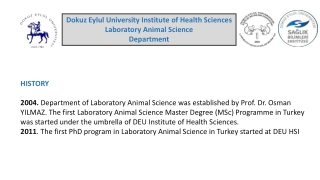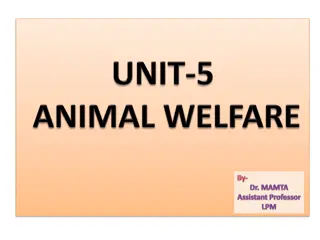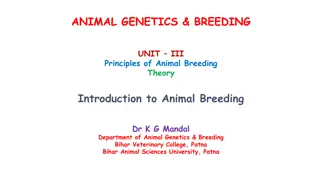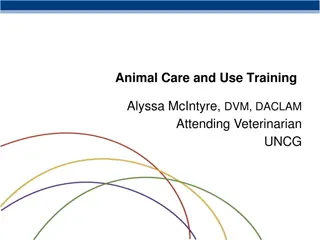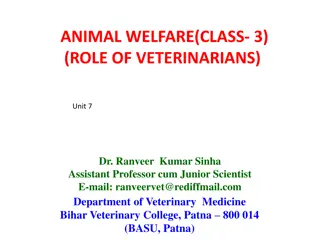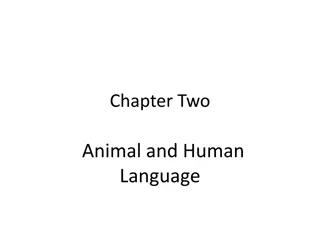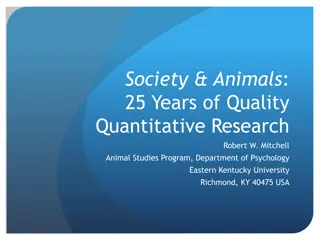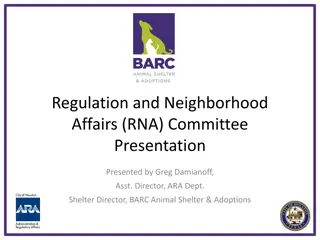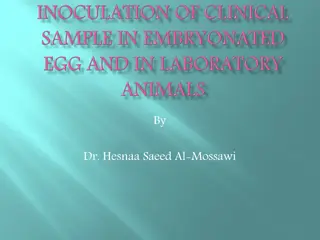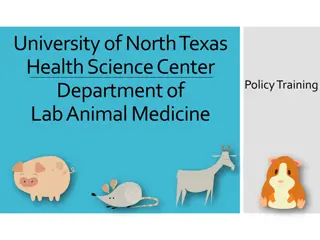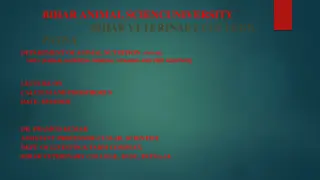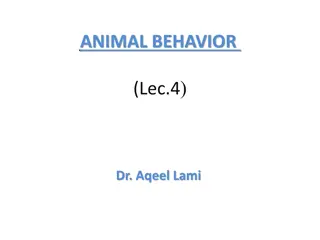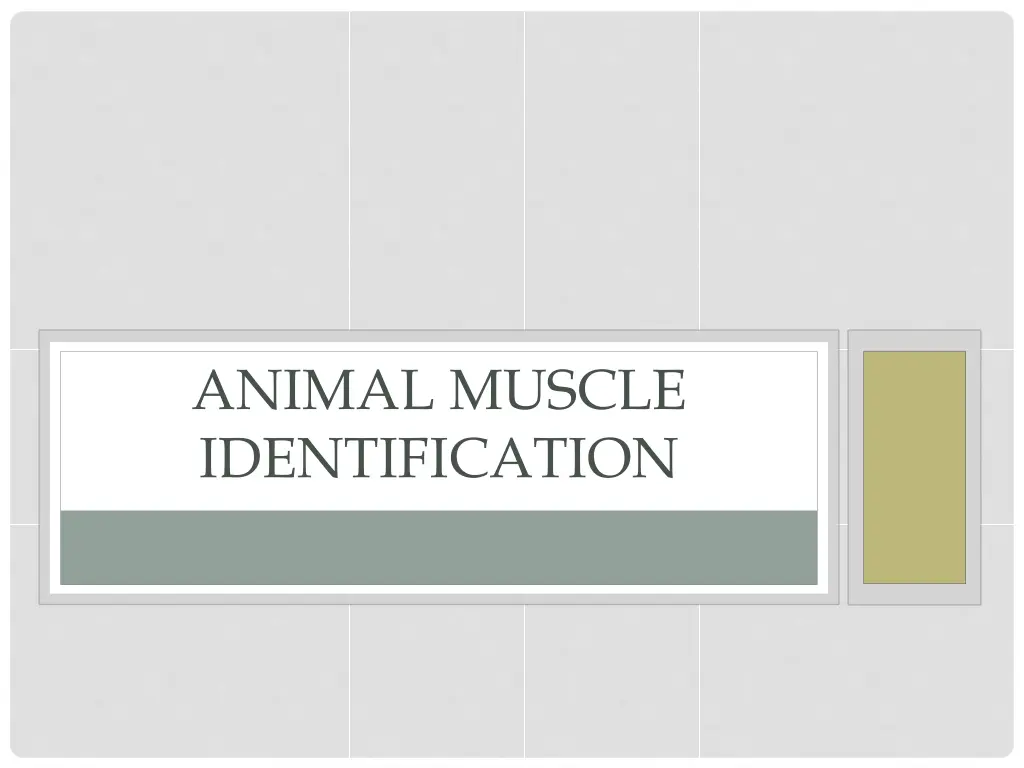
Understanding Animal Muscle Types and Function
Explore the different types of muscles in animals including skeletal, smooth, and cardiac muscles. Learn about their functions, appearances, and anatomical diagrams, with a focus on specific muscle groups like head and neck muscles, arm and shoulder muscles, and pelvis and thigh muscles. Discover the complexity and importance of muscle anatomy in various animal species.
Download Presentation

Please find below an Image/Link to download the presentation.
The content on the website is provided AS IS for your information and personal use only. It may not be sold, licensed, or shared on other websites without obtaining consent from the author. If you encounter any issues during the download, it is possible that the publisher has removed the file from their server.
You are allowed to download the files provided on this website for personal or commercial use, subject to the condition that they are used lawfully. All files are the property of their respective owners.
The content on the website is provided AS IS for your information and personal use only. It may not be sold, licensed, or shared on other websites without obtaining consent from the author.
E N D
Presentation Transcript
ANIMAL MUSCLE IDENTIFICATION
TYPES OF MUSCLES SKELETAL MUSCLES: HAVE A STRIPED APPEARANCE, INCLUDE VOLUNTARY AND INVOLUNTARY, ATTACHED TO AND MOVES YOUR BONES. THIS IS A MAJORITY OF THE MUSCLE TISSUE IN YOUR BODY.
TYPES OF MUSCLES Smooth Muscles: Involuntary muscles, found in the walls of internal organs and the blood vessels.
TYPES OF MUSCLES CARDIAC MUSCLES: MUSCLES THAT FORM A NETWORK TO MAKE UP THE HEART.
HEAD AND NECK MUSCLES Masseter Elevates the mandible Brachiocephalic Helps to protract the arm Trapezius Helps to keep the scapula in place and move it forward and backward.
ARM AND SHOULDER MUSCLES Latissimus Dorsi Major retractor muscle of the arm Deltoid Helps to protract the upper arm Deep Pectoral Adducts the limb and pulls the limb caudally Triceps Brachii Extends the elbow and flexes the shoulder Biceps Brachii Flexor of the forearm
PELVIS AND THIGH MUSCLES Tensor Fasciae Latae Helps to extend the shanks, as well as to protract the thigh at the hip joint. Semitendinosus Assists the biceps femoris in thigh retraction and shank flexion Gastrocnemius and Soleus Extend the foot
TRUNK MUSCLES External/internal oblique Compresses the abdomen and flexes the trunk Rectus abdominis Supports the abdominal wall and ventrally flexes the abdomen
HEAD AND NECK MUSCLES Masseter Located in the cheek, its function is to move the jaw and teeth. Brachiocephalicus Aids in the movement of the leg and shoulder. Also, acts as a lateral flexor in the neck. Trapezius Aids in movement of the scapula.
ARM AND SHOULDER MUSCLES Deltoid Abducts the arm. Triceps Brachii Extends the elbow. Biceps Brachii Flexes the arm and forearm. Brachialis Flexes the elbow. Latissimus Dorsi Flexes the shoulder. Deep Pectoral Extends the shoulder joint, elevates the trunk when limb advances, and retracts limb.
TRUNK, PELVIS, AND THIGH MUSCLES Gastrocnemius Extends the hock or flexes the stifle joint. Internal/External Abdominal Oblique Compresses the abdomen and flexes the trunk. Tensor Fasciae Latae Flexes the hip joint, and extends the stifle joint. Middle Gluteal Extends the hip and abducts the limb. Biceps Femoris Extends the hip, stifle, and hock joints, and flexes the stifle when the hind foot is off the ground. Semitendinosus Extends the hip, stifle and hock joint, and flexes the stifle joint when the hindfoot is lifted from the ground.
SHEEP MUSCLE ANATOMY DIAGRAM 24 Tensor Fasciae Latae 3 Trapezius 18 Latissimus Dorsi 22 Middle Gluteal 20 Internal Abdominal Oblique 2 Brachiocephalicus 1 Masseter 21 External Abdominal Oblique 26 Biceps Femoris 8 Deltoideus 27 Semitendinosus 6 Deep Pectoral 10 Brachialis 28 Gastrocnemius
HEAD AND NECK MUSCLES Masseter Elevates the jaw to help aid in the process of chewing. Trapezius Rotates, elevates, and retracts scapula. Brachiocephalicus Aids in the movement of the leg and shoulder.
SHEEP MUSCLE ANATOMY DIAGRAM 24 Tensor Fasciae Latae 3 Trapezius 18 Latissimus Dorsi 22 Middle Gluteal 20 Internal Abdominal Oblique 2 Brachiocephalicus 1 Masseter 21 External Abdominal Oblique 26 Biceps Femoris 8 Deltoideus 6 Deep Pectoral 10 Brachialis 28 Gastrocnemius
ARM AND SHOULDER MUSCLES Deltoideus Moves and stabilizes the shoulder joint. Deep Pectoral Adducts the limb and stabilizes shoulder joint Latissimus dorsi Extends, adducts, and medially rotates arm Brachialis Flexes the elbow
SHEEP MUSCLE ANATOMY DIAGRAM 24 Tensor Fasciae Latae 18 Latissimus Dorsi 3 Trapezius 22 Middle Gluteal 20 Internal Abdominal Oblique 2 Brachiocephalicus 1 Masseter 21 External Abdominal Oblique 26 Biceps Femoris 8 Deltoideus 6 Deep Pectoral 10 Brachialis 28 Gastrocnemius
TRUNK, PELVIS, AND THIGH MUSCLES Internal/External Abdominal Oblique Flexes abdomen Tensor Fasciae Latae Abducts hip Middle Gluteal Extends hip and abducts limb Gastrocnemius Flexes the knee. Biceps Femoris Flexes and rotates the knee
SHEEP MUSCLE ANATOMY DIAGRAM 24 Tensor Fasciae Latae 22 Middle Gluteal 3 Trapezius 18 Latissimus Dorsi 20 Internal Abdominal Oblique 2 Brachiocephalicus 1 Masseter 21 External Abdominal Oblique 26 Biceps Femoris 8 Deltoideus 6 Deep Pectoral 10 Brachialis 28 Gastrocnemius

